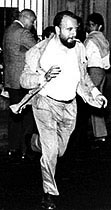He was born in Buenos Aires on January 15th 1931. He began his art studies Cecilia Marcovich's and Tomás Maldonado's studios. He wrote poems and stories that appeared in literary magazines.
In 1950, he published Fiesta, verses, in a cheap edition. He travelled to Europe in June 1954. Shortly after this, he exhibited for the first time in the La Roue gallery in Paris. In 1956, he returned to Buenos Aires where he painted a mural for the Faculty of Law and exhibited in Galería Antígona.
The following year, he settled in Rio de Janeiro and showed his works at the Petite Galerie and, in 1958, in the São Paulo Museum of Modern Art. In Brazil, he was acknowledged as a “tachista” painter and from there he organised the Artists of São Paulo exhibition, in which he was included, held at Galería Antígona in Buenos Aires.
In 1959, he joined the Movimiento Informalista Argentino (Argentine Informalist Movement), along with Enrique Barilari, Kenneth Kemble, Fernando Mazza, Mario Pucciarelli, Towas and Luis Alberto Wells, and presented the tendency at Galería Van Riel and at the Museo de Artes Plásticas “Eduardo Sívori” (this last exhibition being organised by the Museo de Arte Moderno de Buenos Aires). During that year, he also exhibited with Pucciarelli, Florencio Méndez Casariego and Estela Newbery at Galería Pizarro.
The following year, he exhibited his "black paintings" in Galería Pizarro. At the
IV Salón Arte Nuevo 
, held at the Museo Eduardo Sívori, he showed a burnt trunk and framed floor cloths. He covered the centre of Buenos Aires with posters on which could be read “Greco, how great you are” and "Greco: the greatest informalist painter of America".
In 1961, he exhibited Las monjas (The nuns) at Galería Pizarro and he gave a lecture on Informalism at the Sociedad Argentina de Artistas Plásticos ("vital painting, scream painting"). Towards the end of that year, he went to France. There, he participated in Pablo Curatella Manes et Trente Argentins de la Nouvelle Génération exhibition, organised by Germaine Derbecq at Creuze gallery in 1962, where his first work of "Living Art" was displayed: 30 ratones de la nueva generación (30 mice of the new generation). On March 12th, he held the Primera exposición de arte vivo (First exhibition of Living Art) in the streets of Paris, where the Argentine artist Alberto Heredia was enclosed in a chalk circle drawn on the ground by Greco. The following day, uninvited, he took part in Antagonisms 2. The object in the Paris Museum of Decorative Art: on one of the days he appeared as a sandwich man. The posters read, “Alberto Greco, a special work". Using Ives Klein's ball-point pen, he signed two works of Living Art, a Duchess and a Beggar. In June, in Genoa, he wrote the Vivo-Dito Manifesto.
He settled in Rome. In 1963, in the Laboratory Theatre, he presented Christ 63, a performance carried out with Carmelo Bene and Giuseppe Lenti. The scandal that the work caused resulted in their being thrown out of the city. They moved to Madrid and spent a season in Piedralaves where he wrote and drew the Manifiesto-Rollo del Arte-Dito, in which can be read "only what we invented is real". It is signed by “Auntie Ursulina Pértica”, the artist's philosophical alter ego. On returning to Madrid, he produced the Vivo-Dito Trip on foot in the underground from [Puerta del] Sol to Lavapiés.
From Spain, he managed the exhibitions of Saura (1963) and Millares (1964) held at the Museo de Arte Moderno de Buenos Aires. In 1964, he produced works together with Millares and Saura, and with the latter, Crucifixión y Asesinatos (Crucifixion and murders) on the occasion of the assassination of J. F. Kennedy. In May, he opened a solo exhibition at Galería Juana Mordó in Madrid. In Galería Bonino in Buenos Aires, he produced Mi Madrid querido (My beloved Madrid), a Vivo-Dito show involving the Spanish dancer, Antonio Gades.
He visited New York where, in 1965, he put on the Rifa Vivo-Dito in [Grand] Central Station, with the participation of Liechtenstein, Oldenburg, Christo and Spoerri, among others. Later, he “signed” Jackie Kennedy on 5th Avenue. He met Marcel Duchamp.
In May, he returned to Spain with Claudio Badal. In Madrid, he put on a one day exhibition at Galería Edurne with Millares and the Zaj group. That summer, in Ibiza, he wrote his novel Besos Brujos. He returned to Madrid and then left for Barcelona, where he committed suicide by taking barbiturates on October 12th.
